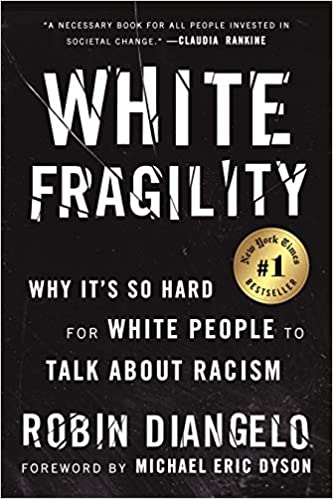
I recently finished reading White Fragility – Why It’s So Hard for White People to Talk About Racism, the book by Robin DiAngelo that took off in light of the Black Lives Matter (BLM) protests following the death of George Floyd.
NOTE: This is not a BLM book – it was published two years ago, and was based on an article DiAngelo had published in 2016. In the light of the BLM movement, her book – with its straightforward approach and ease of access – resonated with, especially, whites trying to come to grips with racism (“Am I a racist?” – DiAngelo: “Yes, we all are”).
Before I give my thoughts on the book in general, I want to address some of the criticisms of the book, which seem to mainly land in one of three buckets:
- Not much for black people here.
- Sorta reads like each chapter is an diversity seminar session.
- The Jackie Robinson quip.
Not much for black people here:
Perfectly valid claim, but early in the book (second page of “Author’s Note,” a preface of sorts), the author – a middle-aged white woman – makes clear that this book’s intended audience is white people, mainly US or Western Europe whites:
I am mainly writing to a white audience; when I use the terms usus and we, I am referring to the white collective.
Want a perspective of racism that will give blacks something to chew on? Read a different book.
Sorta reads like each chapter is an diversity seminar session:
Again, valid claim. But the author has spent 28 years as a diversity trainer, so, yeah, her book might be structured a bit like those.
She could have written it differently, but one of the powers of the book is its accessibility – the shortish chapters highlight issues and don’t get bogged down in the weeds. The “throwing everything I know at this subject” approach is a danger when someone had been immersed for so long in a subject matter. Tell they the time, not how to make a watch.
The Jackie Robinson quote:
The story of Jackie Robinson is a classic example of how whiteness obscures racism by rendering whites, white privilege and racist institutions invisible. Robinson is often celebrated as the first African-American to break the color line and play in major-league baseball. While Robinson was certainly an amazing baseball player, this story line depicts him as racially special. A black man who broke the color line himself. The subtext is that Robinson finally had what it took to play with whites, as if no black athlete before him was strong enough to compete at that level. Imagine if instead, the story went something like this: “Jackie Robinson, the first black man whites allowed to play major-league baseball.” This version makes a critical distinction, because no matter how fantastic a player Robinson was, he simply could not play in the majors if whites – who controlled the institution – did not allow it. If he were to walk onto any field before being granted permission by white owners and policy makers, the police would have removed him.
I’ll admit, I found the way she approached it as somewhat eye-opening.
If the color barrier was still in place when I was in my late teens or early 20s, it would be natural for me – a white dude – to think if I had mad baseball skills then of course I’d get at least a shot in the Majors.
But for black baseball players, mad skills didn’t matter. Pigmentation did.
And it’s not as if Jackie Robinson was the first black to be skilled enough to do well in the Majors – it’s that he was the first to be given permission – by white people – to try. White privilege.
There were surely hundreds of black baseball players who could have made it – Robinson was just the first to be allowed.
It seems obvious that DiAngelo’s spin doesn’t change anything, and it should be obvious that Robinson didn’t “break” the color barrier himself; he was allowed to do so.
Except it’s not obvious to everyone – I’ve never read an account of Robinson’s barrier-breaking that includes the words permission or allowed.
It’s a subtle but telling difference.
My take on the book:
DiAngelo’s premise is that we are all racists – at least white Americans and Western Europeans.
Why? We live it what has been a systematically racist society for quite some time, and one is a product of one’s society. You plant a tomato seed, and you get a tomato plant. They are inextricably linked. And we (whites) are unwilling to own this white privilege when called out on it (fragility). Compelling thesis.
The chapters are a bit like bite-sized seminar snacks, but that’s, to me, the strength: It just touches on the details that need to be touched on, and, as mentioned above, doesn’t go too deep into the weeds and lose the reader.
By offering examples from her seminars, as well as her own experiences, DiAngelo describes on some petty racist behavior that, at first blush, doesn’t seem too racist-y. But that’s through white eyes. Example (author’s misstep): Commenting – in jest – about a black female co-worker’s hair to another black female. Black and white females have some radically different issues with their hair.
Overall, the book – though light on content – did a good job of showing how systemic racism and white privilege/fragility exist in our society.
This is not Sir Isaac Newton’s Philosophiæ Naturalis Principia Mathematica, it’s Carl Sagan’s Cosmos. Which is fine.
Quibbles
I did find, especially near the end of the book when the author discussed how to discover and work on our racism, that the book became a little too personal and preachy.
And she never really explains – that I took away – how to stop being racist. She acknowledges that we’ll all continue to be racist in some shape or form, but no good tips on how to minimize/identify such activity. (I have one – if you start a sentence with the caveat, “This may sound racist, but…”, just stop. Ditto for misogynistic, sexist and so on.)
